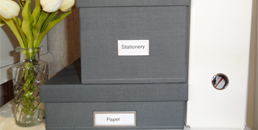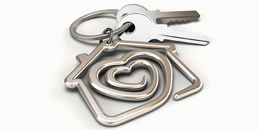by Natalie Morey | Sep 18, 2023 | Declutter tips, Home Organisation, Pantry Declutter, Pantry organization, Tips
Welcome to our Spring Declutter Challenge which kicks off on Saturday 23rd of September. All you need is 30 minutes a day (60 minutes if you can) to declutter and refresh as many of those potentially ‘unorganised’ or ‘cluttered’ spaces in your home. Good Luck!
Day 1- Drop Zones
These are the places where we leave things such as paperwork or bills to attend to at a later date such as the kitchen bench or a drawer in the kitchen or office. So here’s our 3 step process to quickly clear this area:
Step 1 – Spend 30 minutes going through old paperwork or bills and decide whether you need to keep them anymore.
Step 2 – Throw away/shred anything you no longer need and recycle old newspapers and junk mail.
Step 3 – Think about whether you could organise the space differently by using different storage options like a magazine file for paperwork, intray or a box to keep all the incoming bills and mail in.
Officeworks has a great range of magazine/file holders in beautiful colours! Check out their full range here.

Day 2 – Fridge Declutter
What is lurking in the back of your fridge? Today is the day to go through, shelf by shelf and take out all the items, check the used by dates and throw away anything that’s out of date. Then, do a deep-clean of the interior of your fridge with warm soapy water to wipe out any residue or spilt food you might have missed.
Spring Decluttering Challenge Tip # 1: Baking soda is known to catch and absorb odours so fill up a little bowl and pop it in the fridge too.
Next, place food back in the fridge once checked and remember to keep a list of things that were thrown out and you need to replace.
Spring Decluttering Challenge TIP #2: Create an “Eat me first” section. This works well to reminder you to eat food items before their expiry dates. It’s also handy to keep them at eye level, so they are easy to spot. Don’t forget to store items in air-tight containers too as this will keep them fresher for longer. And remember to give the outside of the fridge/freezer a good clean as well.
If you get into the habit of doing a quick wipe out of your fridge each week, before you pop all your fresh weekly shopping in there, you’ll find it cuts down on this cleaning time.
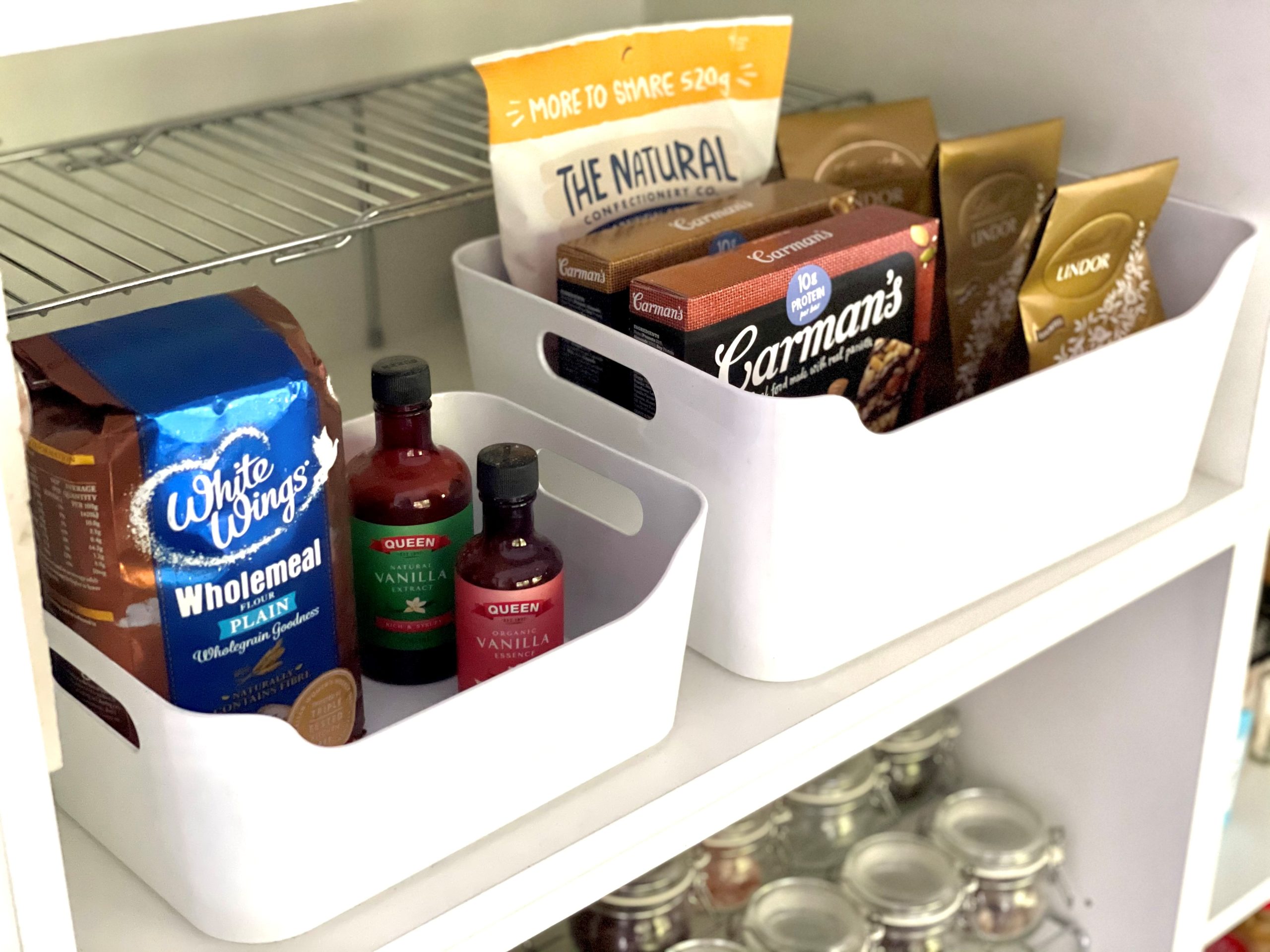
Day 3 – Bathroom Declutter
Spend 30 minutes going through your bathroom drawers, cupboards and throwing away anything that you no longer use. Pay particular attention to your makeup drawer or makeup storage area and if you have time to give the makeup brushes a wash, even better! Don’t forget to give the drawers and cupboards you’ve decluttered a good wipe out as well.
How long should you keep makeup for?
Here is a list of common makeup products and their suggested expiry dates as recommended by Choice. To read the full list from Choice, click here.
- Eyeliners and pencils:Pencil eyeliners are a typically wax-based product and should have no bacterial contamination but keeping them sharpened will help to keep them clean.
- Face and body moisturisers:Unopened, three years. Opened, six months.
- Hairstyling products:Three to five years. Most use alcohol in the formulation, which acts as a preservative. If non-aerosol and no alcohol is listed on the label, then treat as shampoos (see below).
- Lipstick and gloss: Unopened, five years. Opened, 12 months.
- Makeup foundation:Unopened, three years. Opened, six months.
- Mascara and liquid eyeliner(brush in vial): Unopened, three years. Opened, three months.
- Nail polish:Unopened, three years. Opened, six months.
- Nail polish remover:Useable indefinitely.
- Oils and serums: Unopened, three years. Opened, six months.
- Perfumes and aftershaves: Unopened, five years. Opened, 12 months, for best composition. For best longevity, keep them in a cool place away from bright, direct light.
- Self-tanning lotions: Unopened, three years. Opened, six months.
Day 4 – Wardrobe Declutter
A spring declutter challenge would not be complete with getting in and tackling your wardrobe. Now, you are probably going to need more than 30 minutes on this declutter though.
Start with the hanging section in your wardrobe first and go through item by item. Do you have items that you have not worn in the past 12 months. Perhaps you need to ask yourself the following question – If someone asked you to attend a party, function, coffee catch up or work function – would you wear that item? Consider giving the item to charity or a friend who might make use of it if you don’t think you will wear it. And, if you are holding onto an item because it was expensive, then consider selling the item on a platform such as Facebook Marketplace or a luxury second hand clothing retailer.
Next, put things back in the wardrobe and group like items together and colour block them i.e., put all white shirts together and so on.you can do the same process for your folded items too.
Spring Decluttering Challenge TIP # 1 Bag up all your unwanted items and pop them straight in your car ready to drop off at our local charity. The last thing you want is them making there way back into your wardrobe!
Now its onto your underwear and sock drawer to see if there is anything you can immediately throw away based on the condition of the item. You could also look at utilising some storage containers to help keep items more organised if you don’t already have containers. And if you live in a sunny location, perhaps its time to remove big heavy jackets or winter clothing items that won’t be worn till next year. You could pop them in a space bag and store elsewhere and rotate your wardrobe making summer items more accessible.
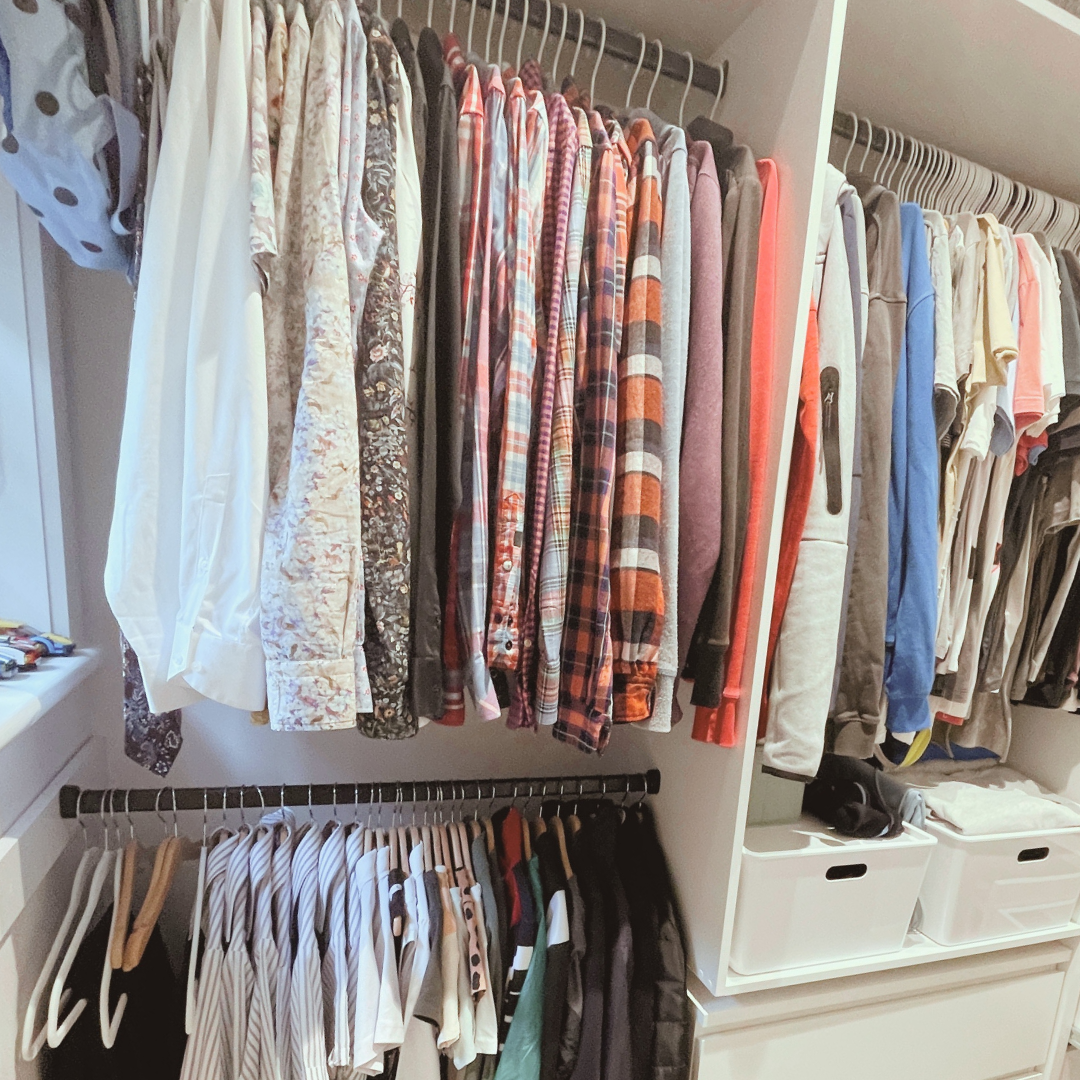
Day 5 – Spring Decluttering Challenge – Pantry Declutter
One of our favourite areas of the home to organise. Given we use this area every day, it makes sense to have a well organised and functional space.
Step 1 – Start by removing everything and checking the use by dates on all food items and throw away anything out of date.
Spring Decluttering Challenge TIP #1. Don’t forgot to start a list of items that you need to replace. There’s nothing worse when you are halfway through cooking something and you realise that you threw that ingredient out last week.
Step 2 – Next, identify items that you don’t think you will use and bin them.
Step 3 – Wipe out your pantry with warm soapy water and dry thoroughly.
Step 4 – Finally, set up zones or areas in your pantry, grouping like items together and put items that you use the most at the front and easily accessible.
Now is also the perfect time to think about better ways to store and display pantry items. Consider purchasing some containers to help you sort them into categories. Plastic tubs, baskets or Lazy Susan’s are great to help keep things organised. And, if you don’t have labels on your containers, then now is the perfect time to pop some on.
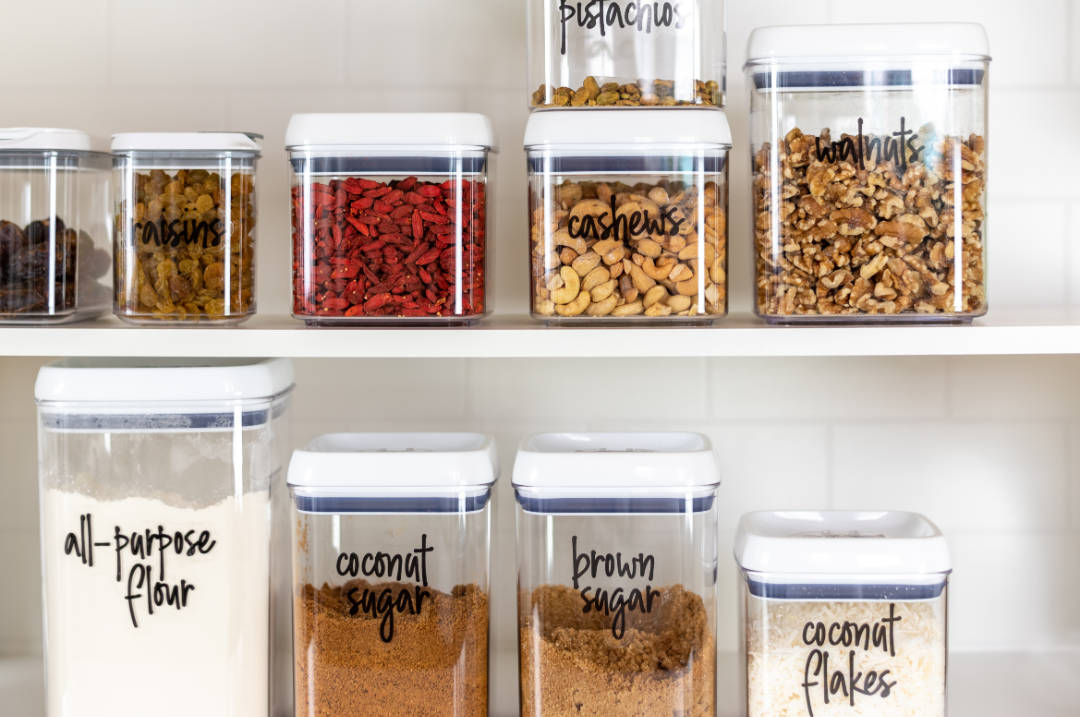
Day 6 – Garage Spring Declutter Challenge
Often we place items in the garage that we no longer need or use inside the home, and they stay in the garage for years or until we move house! So know is the time to go through big items that are taking up valuable space and think about whether you will ever use these again or whether family members have outgrown them. You may be able to sell items like extra furniture, kid’s bikes, scooters or ski gear that has been outgrown. You can also check out your local Facebook pages for groups like “Buy, Swap and Sell”, “Buy Nothing” or “Things for Free”. Otherwise you might be time to organise a hard rubbish collection.
For more garage organising tips, check out this blog.
Day 7 – Laundry Declutter
Usually the laundry isn’t too bad, unless the laundry/utility room is your dumping ground for things that don’t have a home or place to put them. Spend 30 minutes removing anything that doesn’t belong in there and make sure it’s put back into a place with other like items. Now its time to give the washing machine seal a good wipe out. The dirt that disappears from your clothes, towels and sheets has to go somewhere! Your washing machine might also harbor leftover detergent, hard-water deposits and mildew around the lid. That means grime can build up inside your washing machine over time.
To ensure your freshly washed clothes and linens are as clean as possible, follow these steps on how to clean a washing machine. These instructions work for cleaning front-loading and top-loading washing machines, but it’s worth checking if your particular brand has any special requirements.
If your washing machine has a self-clean function, choose that cycle and follow the manufacturer’s instructions to clean it. If it does not, then follow these steps.
Step 1 – Run an empty, regular cycle on hot, using two cups of white vinegar instead of detergent which you add to the detergent dispenser. And don’t worry about harming your machine, as white vinegar will not damage clothes. The hot water-vinegar combo removes and prevents bacteria growth. Vinegar can also act as a deodorizer and cut through mildew odours.
If you have a top-loading washer, you can pause the machine during the hot-water cycle. Allow the tub to fill and agitate for about a minute, then pause the cycle for an hour and let the vinegar soak, then empty. You could also add some lemon juice to the water.
Step 2 – Wipe down the machine’s exterior using a damp cloth and the vinegar water solution. To prevent Mold or mildew growth, leave the door open for a few hours after each wash to let the moisture dry out.
Step 3 – Do a deep clean and use a toothbrush to scrub hard-to-reach spots around the lid and under the rim of the tub. And don’t forget your dryer. Wipe over your dryer especially where lint can accumulate.
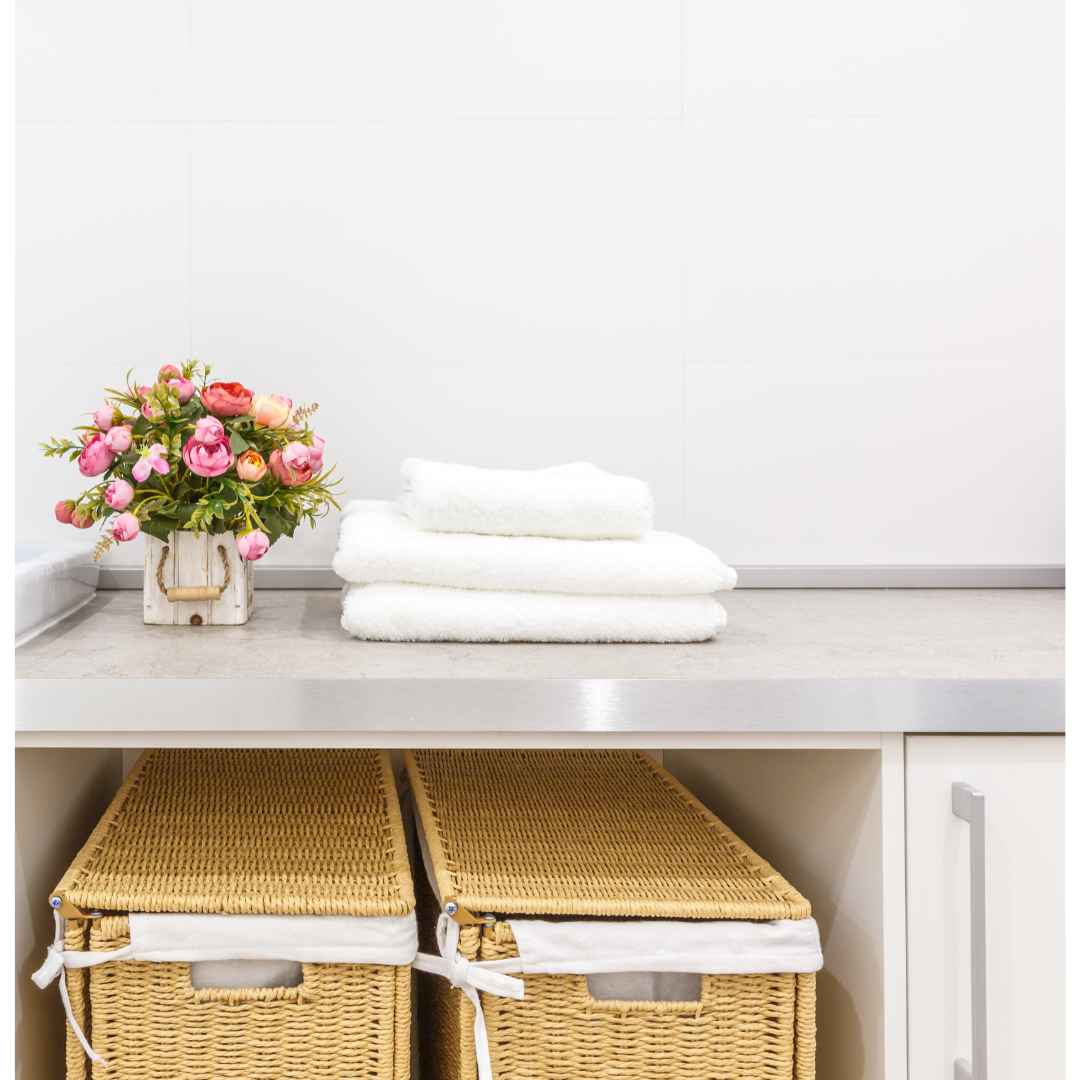
We hope that our Spring Decluttering Challenge has been useful. For other great home organisation, decluttering or styling tips see our other BLOG articles.
by Natalie Morey | Sep 11, 2023 | Declutter tips, Home Organisation
- Set aside a dedicated time to declutter your garage, such as a weekend or a few evenings. This will allow you to focus on the task at hand without interruption.
- Start by removing everything from your garage and sorting it into different categories. This can include categories such as tools, sports equipment, gardening supplies and holiday decorations.
- Get rid of items that you no longer need or use. If something has been unused for over a year, it’s likely that you can do without it. Consider donating or selling items that are still in good condition.
- Invest in storage solutions such as shelves, cabinets and hooks to help keep your garage organised. This will allow you to keep items off the floor and create designated spaces for different categories of items.
- Group similar items together to make them easier to find. For example, keep all your gardening tools in one area and all your sports equipment in another.
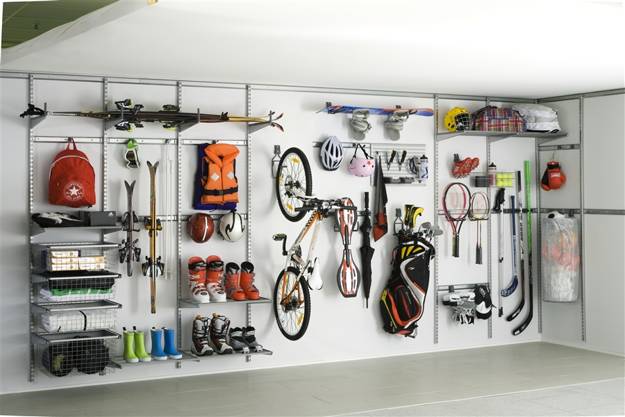
- Make use of vertical space by hanging items on the walls or from the ceiling. This can include things like bicycles, ladders and tools. Utilise wall-mounted storage systems or install pegboards to maximize storage space.
- Label storage containers and shelves to make it easier to find what you need. This will help prevent items from getting misplaced or forgotten about.
- Take advantage of wall space by installing hooks or racks to hang items such as shovels, rakes and brooms. This will keep them off the floor and free up space.
- Create a designated workspace or area for specific activities, such as a workbench for DIY projects or a space for gardening. This will help keep your garage organised and make it easier to find and store the necessary tools and equipment.
- Regularly maintain and clean your garage to prevent clutter from building up again. Dedicate a few minutes each week to organising and tidying up, so you can enjoy a clutter-free space
by Natalie Morey | Jun 21, 2023 | Home Office, Home Organisation, Office Organising, Tips, Virtual PA
It’s that time of year. The end of financial year is nearly here. That means it’s time to get your home office paperwork organised. So, here’s 15 ways to organise your home office. They won’t take you long, but I guarantee that if you take the time to do them you will transform your home office in no time at all.

15 ways to organise your home office
Tip 1: Start with your desk. Clear off any unnecessary items, sort through loose papers and create designated spaces for essentials like pens, notebooks and office supplies.
Tip 2: Tackle your filing system. Sort through old documents and create a system that works for you. Consider digitizing files to reduce paper clutter.
Tip 3: Organise your bookshelf. Donate or sell books you no longer need and arrange the remaining ones in a visually pleasing and accessible manner.
Tip 4: Create a designated space for incoming and outgoing mail. Set up trays or folders to sort and manage your mail effectively.
Tip 5: Assess your storage solutions. Optimize your storage by using bins, baskets or drawer organisers to keep items neat and easily accessible.
Tip 6: Declutter your computer desktop. Organise files and folders, delete unnecessary shortcuts and ensure your digital workspace is streamlined.
Tip 7: Focus on cable management. Use cable clips or cord organisers to keep cables and cords tidy and prevent them from becoming tangled.
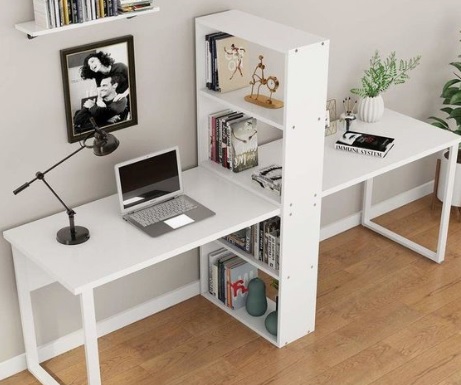
Working From Home
Tip 8: Evaluate your office furniture. Determine if any furniture items are no longer serving a purpose and if so consider replacing or repurposing them.
Tip 9: Sort through office supplies. Discard dried-out pens, markers, or supplies you no longer use. Keep essentials neatly stored in containers or drawers.
Tip 10: Clear out outdated technology. Dispose of old gadgets, cables or electronic devices that are no longer functional or needed.
Tip 11: Declutter your bulletin board or whiteboard. Remove outdated notes or reminders and create a fresh, visually appealing space.
Tip 12: Evaluate your lighting situation. Ensure your workspace is well-lit with an appropriate desk lamp or overhead lighting.
Tip 13: Clean and organise your printer area. Remove any old or unused paper, refill ink or toner and create a designated spot for printing supplies.
Tip 14: Create a system for managing receipts and invoices. Consider using digital tools or apps to store and organise important financial documents.
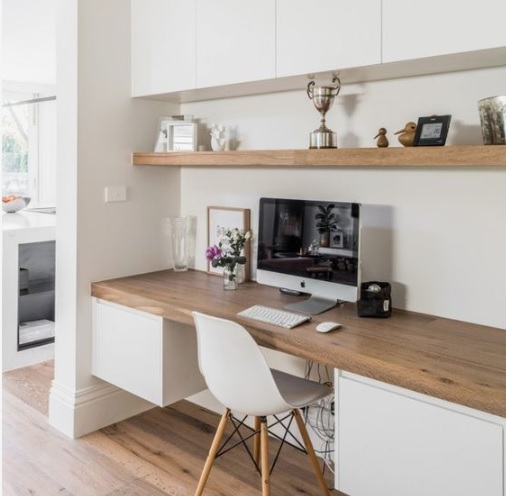
Home Office Ideas
Tip 15: Evaluate your office decor. Remove any items that don’t inspire you or contribute to a productive environment. Add personal touches that bring you joy.
For more tips on getting ready for tax time read this blog. Or if you reed some help to get your home office paperwork organised, then contact us.
by Natalie Morey | Feb 23, 2023 | Declutter tips, Home Organisation, Kids Organising, Pantry Declutter, Pantry organization, School Routine
The holidays are done. School is back and the routine has started. Is anyone else struggling to get back into routine? I think we have come out of COVID lockdowns, then packed everything into last year. Then, when we finally stopped for Christmas holidays, we really stopped. And, it has been extra hard trying to get back into the school routine (even after a few weeks)ol. So, if you are like me and have found it hard getting back into routine here is 8 tips to get you back into routine.
Sunday Session
My preparation for the week starts on a Sunday. Each Sunday I spend a few minutes planning out my week. I have a weekly planner that I put on the fridge, so everyone knows what’s happening and when. All the kid’s activities and classes are listed along with anything else happening for the week. I also list down what we are having for dinner every night. Spending a few minutes on a Sunday always ensures a more organised week. And I know when I don’t do my planning on a Sunday, I inevitably miss something during the week.
Organise your Schedule
In addition to a more detailed weekly planner you should also have a 12 month planner as well. If you haven’t previously done one, it’s not too late to find a planner that suits you. You may prefer a paper planner, a shared online calendar or an app for your phone or tablet. Whichever you choose, start off right by entering times and commitments you already know about.
Pack for Weekly Activities
As mentioned above I list all the kid’s’ activities on my weekly planner. I then ensure all their uniforms are ironed and together on a Sunday. (For my son’s basketball gear, I use one of those combination coat hanger with clips, so his basketball shorts are already on the hanger with his top – so, there’s no last minute panic to find the right shorts).
For the swimming bag, the towels and bathers are put straight back in there after they have been washed. As our swimming lessons are at 5pm I also pack their change of clothes (PJ’s given the time) in the bag as well. That way, I’m not running around madly on swimming night trying to find their gear.
Prepack
Put all the items you’ll need out the night before. This goes for the kids stuff too. School bags are packed, shoes are cleaned and out and their hat is in their bag. Oh, and don’t forget their socks too. This helps avoid that last minute rush too.
Lunch Prep
Start prepping lunch boxes the night before, by packing any fruit and snacks. I generally like to make sandwiches fresh in the morning though, but if everything else is done, then it saves me time. Don’t forget to fill the kids water bottles and pop in the fridge the night before too.
After School Snacks
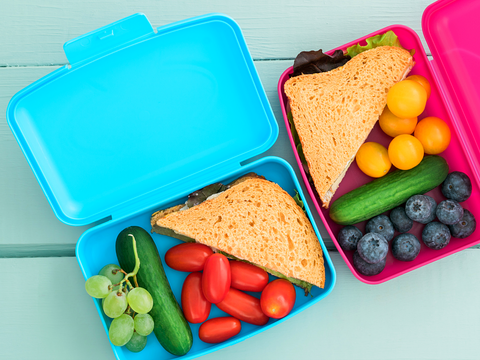
Organise School Lunch Boxes
If the kids are going straight to sport activities after school, pack those snacks separately so you can take them with you when you pick up the kids.
Double Batch your Cooking
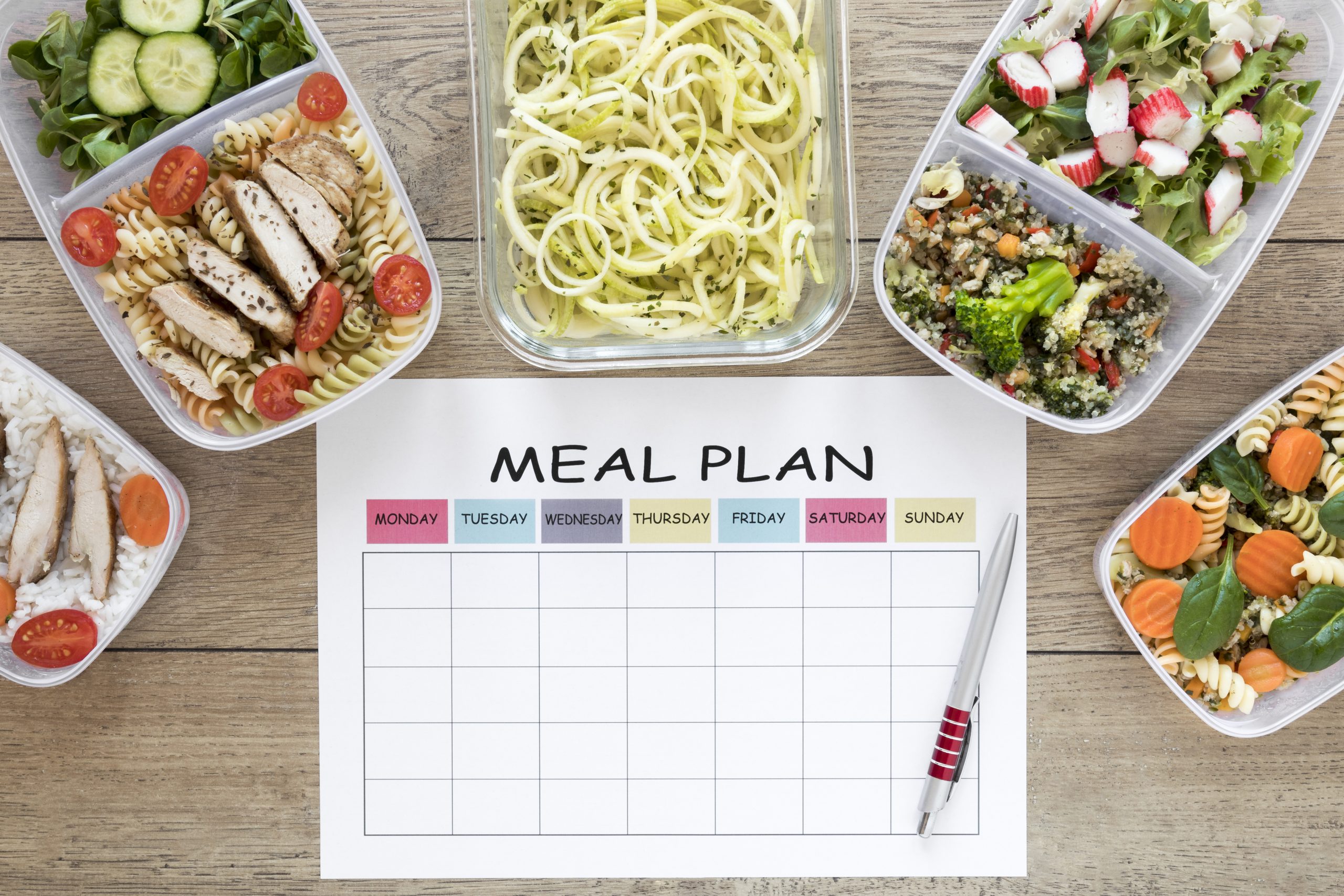
I love having a few pre-prepared meals in the freeze. This is perfect for those busy weeks. So, when I cook something like lasagne I do a double batch, eating one that night for dinner and freezing the other. Last week I starting doing “triple batches” so I have a nice stock pile of Meatballs and Lasagna. Highly recommend. Need a meal planner checklist. Check out this one. Need more inspiration on meal planning, then click here.
Get Up 10 Minutes Early

8 Tips To Get You Back Into The School Routine
Of the 8 tips to get you back into the school routine I think getting up 10 minutes early can make a massive difference. Even if it just gives you time to have a coffee in peace, or double check that everything is organise before the kids get up, it can make a big difference.
I hope these 8 tips to get you back into the school routine help.
by Natalie Morey | Jul 27, 2021 | Declutter tips, Home Office, Home Organisation, Office Organising, Tips
I use these 10 tips for coping during lockdown every single day. They work and help me keep on track of what is a crazy time at the moment.
Make friends with your slow cooker
I’m a bit of a slow cooker connoisseur. I prep my veggies, and get them all cut up and meat ready the night before. Then, in the morning all I need to do is pop them in the slow cooker. After a challenging day of home schooling and wrangling kids and trying to juggle work (and stay sane) I don’t have to think about dinner as it’s done.

10 Tips For Coping During Lockdown – Image Ref: ablissfulnest.com
Batch cooking
If you’re making Spaghetti Bolognese, make a double quantity and freeze the other batch. This week we are having Pumpkin Ravioli, Spaghetti Bolognese and Shepard’s Pie, all out of the freezer. Then all you need to do is cook some veggies or makem a quick salad and dinner is done.
10 minutes a day keeps the pile away
Ironing is probably the last thing on your mind at the moment but if you do 10 minutes a day it will keep it in check.
I miss my cleaner
Obviously, my cleaner cannot come at the moment and the last thing I have time to do is clean. So, I just do 5 minutes here and there. As soon as I have showered, I wipe out the shower. It’s amazing the difference this makes and your shower won’t need a proper clean for weeks. A quick wipe over the bathroom mirror and vanity after the kids have cleaned their teeth means another job done. Five minutes here and there makes a big difference. Although one of the benefits of lockdown is that no one will be coming to visit you anyway, so maybe cleaning doesn’t need to be high on your list either!!!
Take 10 minutes for yourself
Before the craziness of the day starts I make a cup of tea and go and sit quietly (away from the kids) and take the time to drink it in peace (and whilst it’s hot). Its amazing how you feel if you can just get 10 minutes here and there to yourself.

10 Tips For Coping During Lockdown – Image Ref: followtheyellowbrickhome.com
Book that appointment
We won’t be in lockdown for ever (even though it does feel like that some days). So, book that facial or massage now so that when lockdown is finished you have already secured your spot.
Plan out your week
Map out those important meeting that you cannot miss and plan your day around them. Let the family know too. If you need to get the kids set up with Google Meets first thing in the morning, then schedule any “must do” meetings in the afternoon.
Recharge at night
Be sure to recharge all your device e.g., iPads at night ready for the next day of learning.
Bribe your kids
Normally not one that I would suggest but do whatever it takes to get it all done. If you have little kids perhaps start a reward chart for them. They get stickers (and eventually a reward) for doing good things like not coming into the office when you’re on a Zoom meeting, or completing their school work for the day.
The last of my 10 Tips For Coping During Lockdown – Up your vitamins and greens
Let’s be honest, we are all probably burning the candle at both ends. So now is the time to up your dose of Vitamins so you can cope. I know I finished work at 11pm last night so I definitely need some extra energy today.
Good luck with lockdown 5.0. Hopefully it won’t be long and we will be back out again.
Want more tips on coping during lockdown? Then check out our blog on: Master Working From Home.
Whilst we cannot go and do any home organising we are still helping our clients virtually. So if you need some help, we are only a phone call away.
by Natalie Morey | Jul 20, 2021 | Declutter tips, Home Office, Home Organisation, Office Organising
Organising your paperwork for tax time can be a time-consuming and stressful at the best of times. But it’s a hundred times worse when your tax documents and receipts are scattered all over the place and in no logical order. So we have put together some tax time tips to help get you organised.
If you are still using the old shoe box storage system or if you have got receipts shoved in your wallet or worse still you have got no idea where they are, then it’s time to review your home office filing system.
Having a well-organised tax record filing system is the key to making the process a whole lot simpler, quicker and hassle-free.
Here’s our 8 tips to help get you organised.
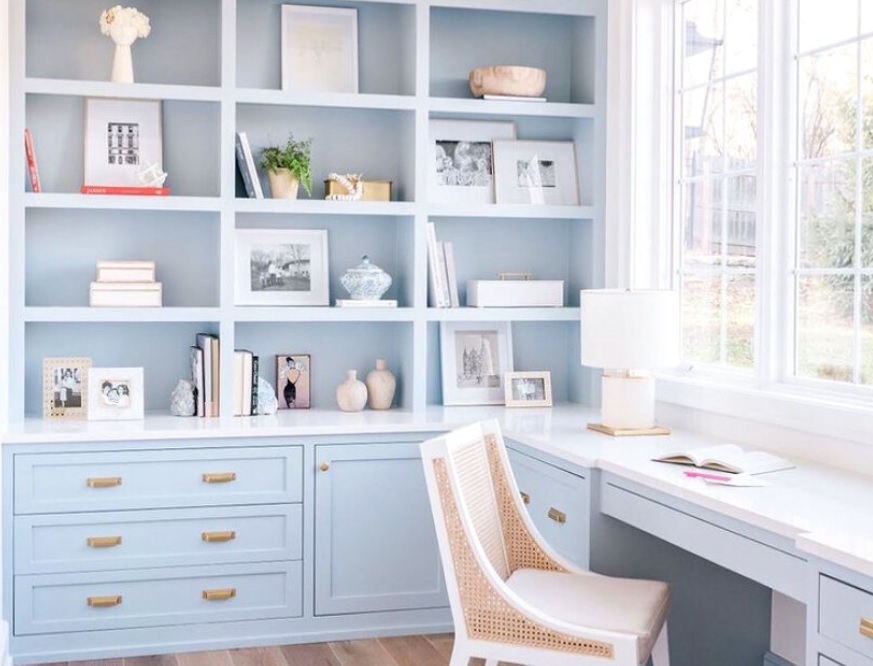
Organising Your Paperwork for Tax Time. Image reference: www.kateknowleshome
1. Set up a filing system
Systems don’t need to be expensive or complicated. A 2-ring binder folder, simple colour-coded manila folders or a concertina file will work if you don’t have a filing cabinet.
2. Understand what you can claim
It’s a good idea to talk to a tax professional and get an idea of what expenses you can claim. This is especially important now if you’re working arrangements have changed (and let’s be honest, nearly all of us have had changed working arrangements in the last 12 months).
Have you purchased equipment so you can work from home – a laptop, desk items, stationery etc.? Find out what you can claim and ensure you have the receipts to prove it.
For more detailed information on what you may be able to claim, check with the ATO.
3. Organising for Tax Time – Decide on your categories
Possible income and expense categories might include:
Income
- PAYG Payment Summaries from your employers
- Interest earned on all bank accounts
- Dividends received on any shares you own
- Distributions paid from Trusts or Partnerships
- Rental income on your rental properties
Expenses
- Working from home expenses.
- Work car related expenses
- Work travel related expenses
- Other work related expenses, such as printing, subscriptions, stationery. Do note that they must relate specifically to your employment.
- Donations
- Education/professional development expenses
- Cost of managing your tax affairs, ie your accountant’s fee for preparing your tax return
4. Collect all the paperwork scattered around the house
You know the ones that have been put in your car, shoved in your wallet, your jacket pocket, in your bedside table or some other random spot.
5. Just do it – Once
Papers don’t file themselves. Set time aside to do this. The best option is to file an item away as soon as you receive it. If you cannot do that, set aside a few minutes each week or month to do this. Perhaps make the last day of each month the day when you will do this. Then, you will avoid a big pile of paperwork and emails to file at the end of tax time.
6. Go Digital – Tax Time Tip
Don’t want papers and files sitting around. Then perhaps its time to go digital. Create folders on your computer and in your inbox so you can file electronic receipts, invoices, bank statements and other digital tax-related documents in the appropriate folders as soon as you receive them.
There are some great apps and online programs like Xero or Myob if you need something more specialised.
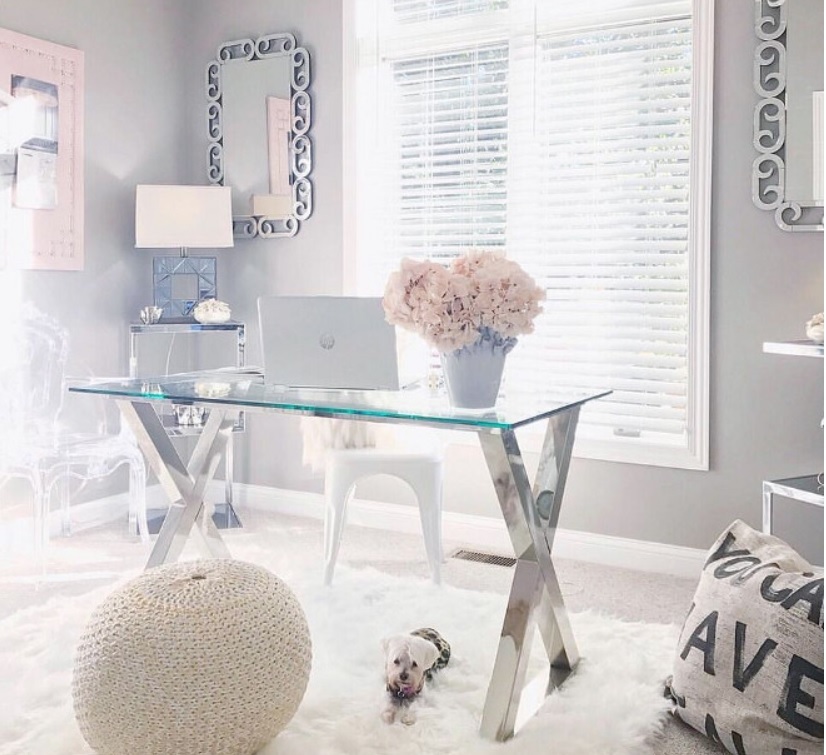
Organising Your Paperwork for Tax Time: image source: homebunch.com
7. The problem with paper
Apart from the clutter that it causes, the other issues with paper records is that once they’re gone, they’re gone. Paper receipts fade and accidents happen. The best way to store receipts these days is electronically. Take a photo and keep it on your phone or laptop or get an app to keep all your receipts in the cloud. Just make sure you set up an online filing and file it logically, so you can find it.
8. Book that appointment
Now that your organising for Tax Time is done and all your paperwork is organised logically in one spot, it won’t take long to pull it all together. So book that appointment with your accountant and get your tax done. And hopefully, now that you have all your receipts together, you might get a nice refund too.
Running A Business From Home
Running a business from home and need some extra support, setting up XERO or Myob, imputing data or lodging your BAS statements. We work with a great company who can manage all your accounting requirements. Just contact us for more information about them.
Need some help organising your paperwork for tax time? Then contact us. We love organising paperwork and home offices.


















